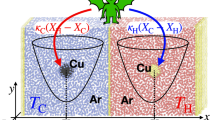Abstract
Plasmon-resonant nanoparticles are being integrated into a variety of actuators, sensors and calorimeters due to their extraordinary optical capabilities. We show a continuum energy balance accurately describes thermal dynamics and equilibrium temperatures in plasmon-resonant nanoparticle systems. Analysis of 18 data sets in which temperature increased ≤10.6 °C yielded a mean value of R 2 > 0.99. The largest single relative temperature error was 1.11%. A characteristic temperature was introduced into a linear driving force approximation for radiative heat transfer in the continuum energy description to simplify parameter estimation. The maximum percent error of the linearized description rose to 1.5% for the 18 sets. Comparing the two descriptions at simulated temperature increases up to 76.6 °C gave maximum relative errors ≤7.16%. These results show for the first time that the energy balance and its linearized approximation are applicable to characterize dynamic and equilibrium temperatures for sensors, actuators and calorimeters containing nanoparticles in microfluidic and lab-on-chip systems over a broad range of heat-transfer lengths, power inputs and corresponding temperature increases.







Similar content being viewed by others
References
Xue M, Li J, Xu W, Lu Z, Wang KL, Ko PK, Chan M. A self-assembly conductive device for direct DNA identification in integrated microarray based system, IDEM ‘02 Digest. IEEE International Electron Devices Meeting, San Francisco, CA, USA, Dec. 8–11, 2002, p. 207–10.
Storhoff JJ, Elghanian R, Mucic RC, Mirkin CA, Letsinger RL. One-pot colorimetric differentiation of polynucleotides with single base imperfections using gold nanoparticle probes. J Am Chem Soc. 1998;120(9):1959–64.
Kneipp K, Haka AS, Kneipp H, Badizadegan K, Yoshizawa N, Boone C, et al. Surface-enhanced Raman spectroscopy in single living cells using gold nanoparticles. Appl Spectrosc. 2002;56(2):150–4.
Kniepp K, Kniepp H, Manoharan R, Hanlon EB, Itzkan I, Dasari RR, et al. Extremely large enhancement factors in surface-enhanced Raman scattering for molecules on colloidal gold clusters. Appl Spectrosc. 1998;52(12):1493–7.
Ahmadi TS, Logunov SL, El-Sayed MA. Picosecond dynamics of colloidal gold nanoparticles. J Phys Chem. 1996;100(20):8053–6.
Logunov SL, Ahmadi TS, El-Sayed MA, Khoury JT, Whetten RL. Electron dynamics of passivated gold nanocrystals probed by subpicosecond transient absorption spectroscopy. J Phys Chem B. 1997;101(19):3713–9.
Link S, El-Sayed MA. Optical properties and ultrafast dynamics of metallic nanocrystals. Annu Rev Phys Chem. 2003;54(1):331–66.
Roper DK, Ahn W, Hoepfner M. Microscale heat transfer transduced by surface plasmon resonant gold nanoparticles. J Phys Chem C. 2007;111(9):3636–41.
Incropera F, DeWitt D. Fundamentals of heat and mass transfer. 5th ed. Hoboken: Wiley; 2002. p. 699–756, 905–932 (Chapter 12, Appendix A).
Roper M, Easley C, Legendre L, Humphrey J, Landers J. Infrared temperature control system for a completely noncontact polymerase chain reaction in microfluidic chips. Anal Chem. 2007;79(4):1294–300.
Eeles R, Stamps A. Polymerase chain reaction (PCR) the technique and its applications. Boca Raton: CRC Press; 1993. p. 4–11 (Chapter 2).
Lindfield G, Penny J. Numerical methods using Matlab. 2nd ed. Upper Saddle River: Prentice Hall; 2000, p. 200–249, 305.
Acknowledgements
This work was supported in part by NSF (NER) ECCS-0709456 and by NSF CMMI-0909749. The authors would like to acknowledge Ms. Wonmi Ahn for technical assistance.
Author information
Authors and Affiliations
Corresponding author
Rights and permissions
About this article
Cite this article
Hoepfner, M.P., Roper, D.K. Describing temperature increases in plasmon-resonant nanoparticle systems. J Therm Anal Calorim 98, 197–202 (2009). https://doi.org/10.1007/s10973-009-0316-9
Received:
Accepted:
Published:
Issue Date:
DOI: https://doi.org/10.1007/s10973-009-0316-9




